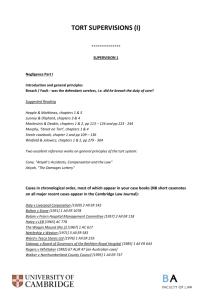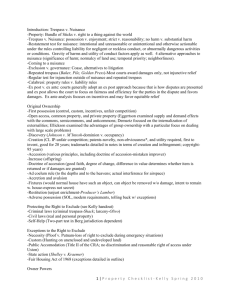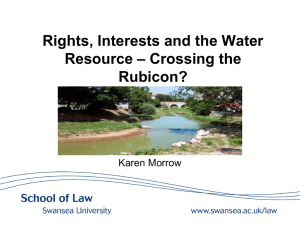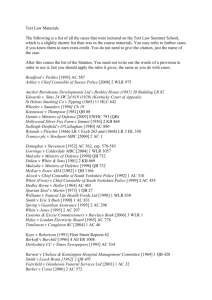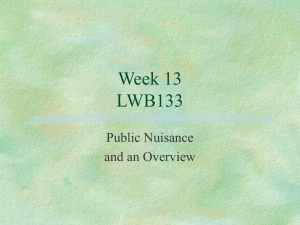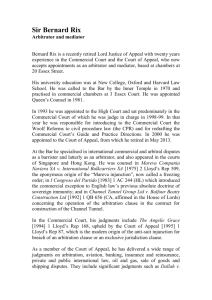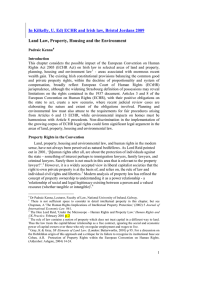Environmental Damages
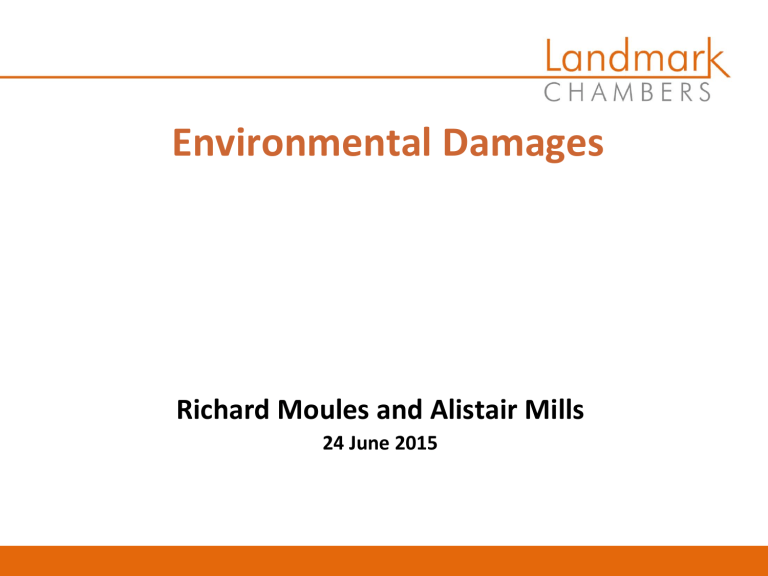
Environmental Damages
Richard Moules and Alistair Mills
24 June 2015
Introduction
• This paper considers the principal causes of action for recovering damages in environmental law:
• Claims under the HRA 1998
• Public and private nuisance (including Rylands v Fletcher )
• Negligence; and
• Breach of statutory duty
General nature of private law environmental claims
Key features of environmental torts
• Concerned with the protection of private rights
• Balances private rights using concept of reasonableness rather than imposing universal pollution limits
• Causation difficulties
• Remedy usually damages
• But may require more that regulatory regime & give a remedy where public law cannot
Human Rights claims
Key provisions of the HRA 1998
• Section 6: 3 types of ‘public authority’
• Section 7: standing for ‘victims’
• Section 8: power to award damages but only if the “court is satisfied that the award of damages is necessary to afford just satisfaction to the person in whose favour it is made”
Article 8 –severe pollution cases
• Lopez Ostra v Spain (1995) 20 EHHR 277
• Guerra v Italy (1998) 26 EHRR 357
• Taskin v Turkey (2006) 42 EHRR 50
• Fedayeva v Russia (2005) 41 EHRR 376
• Giacomelli v Italy (November 2, 2006)
Article 8 –noise pollution cases
• Powell v Rayner (1990) 12 EHRR 395
• Hatton v UK (2003) 37 EHRR 28
• Ashworth v UK (January 20, 2004)
Article 8 –relationship with common law nuisance
• Dobson v Thames Water Utilities Ltd [2009] EWCA Civ 28
• No need for a property interest to claim HRA damages
• But courts will be astute to prevent double recovery
Article2
• Őneryilditz v Turkey (2005) 41 EHRR 325
• Positive obligation to take steps to safeguard life engaged by environmental disaster
Article 1 Protocol 1
• Article 1 of Protocol 1 ECHR provides that:
• ‘Every natural or legal person is entitled to the peaceful enjoyment of his possessions. No one shall be deprived of his possessions except in the public interest and subject to the conditions provide for by law and by the general principles of international law.’
• 3 limbs: (1) interferences with enjoyment of possessions; (2) deprivation of possessions; and (3) control on use of property
Article 1 Protocol 1 –cases
• Powell and Rayner v UK (1986) 9 EHRR 375
• S v France 65 DR 250
• Dennis v MoD [2003] Env LR 34
• Vearncombe v UK and Germany 59 DR 200
Article 1 Protocol 1 –con’t
• A1P1 may also be engaged when the state tries to impose environmental controls on landowners e.g.
• R (Trailer & Marina (Leven) Ltd) v SSEFRA [2005] 1 WLR 1267
• A1P1 was also engaged by the reduction of feed-in tariffs for small scale solar energy producers: Department for Energy and Climate Change v Breyer Group Plc [2015] EWCA Civ 408
Private Nuisance
Definition
• Reed v Lyons & Co Ltd [1947] AC 156
• An unlawful interference with a person’s use or enjoyment of land or some right over, or in connection with it
• Includes (a) physical damage to the claimant’s land; and (b) interferences with the claimant’s use and enjoyment of land
Key features
• Hunter v Canary Wharf Ltd [1997] AC 156 –need for a proprietary interest
• Sedleigh-Denfield v O’Callaghan [1940] AC 880 – unreasonable interferences
• Sturges v Bridgman (1879) 11 Ch D 852 –the character of the area is relevant
Key features (2)
• Cambridge Water Co Ltd v Eastern Counties Leather Plc [1994]
2 AC 264 –damage sustained must be foreseeable
• Northumbrian Water Ltd v Sir Robert McAlpine Ltd [2014] BLR
605 –foreseeability required for physical damage claims not just sensibility cases
• Robinson v Kilvert (1884) 41 Ch D 88 – abnormally sensitive claimants cannot claim
• Heath v Brighton (1908) 98 LT 718 –abnormally sensitive vicar
Coventry v Lawrence [2014] AC 822
• Issues:
(1)Whether the right to emit noise can be acquired by long user
(2)Whether coming to a nuisance is a defence
(3)Whether D’s actions are relevant to the character of the area
(4)The relevance of a planning permission
(5)When the court should grant an injunction rather than award damages in lieu of an injunction (considering Shelfer v City of
London [1895) 1 Ch 28
Public Nuisance
Definition
• Ag v PYA Quarries (1957) 2 WLR 770
“a public nuisance is one which materially affect the reasonable comfort and convenience of life of a class of
Her Majesty's subjects who come within the sphere or neighbourhood of its operation; the question whether the number of persons affected is sufficient to constitute a class is one of fact in every case and it is sufficient to show that a representative cross-section of that class has been so affected for an injunction to issue."
Key features
• No need for an interest in land
• Nuisance must affect a class or section of the public
• AG or local authority can sue, so can an individual who has suffered special damage
• Wandsworth LBC v Railtrack Plc [2002] QB 756 -3 elements for liability (a) knowledge of existence of a nuisance; (b) means reasonably open to D to abate it; and (c) failure to abate within a reasonable time
The rule in Rylands v Fletcher
The rule
• “We think that the true rule of law is, that the person who for his own purposes brings on his lands and collects and keeps there anything likely to do mischief if it escapes must keep it at his peril, and, if he does not do so, is prima facie answerable for all the damage which is the natural consequence of its escape."
• 4 elements: (a) thing brought onto land; (b) escape; (c) thing likely to do mischief; and (d) extraordinary or unusual use of the land
The 4 ingredients of the tort
• Giles v Walker (1890) 24 QBD 656 –thing brought onto the land
• Reed v Lyons [1947] AC 156 –the thing must escape
• Gore v Stannard (t/a Wyvern Tyres) [2014] QB 1 –tyres not likely to do mischief if they escape
• Cambridge Water Co v Eastern Counties Leather plc [1994] 2
AC 264 –foreseeability introduced
• Transco v Stockport MBC [2004] 2 AC 1 –Lord Hoffmann’s scepticism about this esoteric tort
Negligence
Ingredients of the tort
• Duty of care
• Breach of duty
• Damage
• Causation
• Foreseeability
• Corby Group [2009] EWHC 1944 (TCC)
Breach of statutory duty
Ingredients of the tort
• Statute creates an obligation
• Statute allows a civil claim
• Harm suffered by C within the general class of risks at which the statute is directed
• C is a member of the class protected by the statute
• D breached the statute
• Breach caused the damage to C
• Corby Group [2009] EWHC 1944 (TCC) –breach of ss.33(1)(c) &
34(1)(b) Environmental Protection Act 1990
Aarhus costs issues
The right to affordable litigation
• Article 9(3) Aarhus Convention
“…each party shall ensure that…members of the public have access to administrative or judicial procedures to challenge acts and omissions by private persons and public authorities which contravene provisions of its national law relating to the environment”
• Art 9(4) such procedures must not be “prohibitively expensive”
• CPR 45.41(2) fixed costs for Aarhus convention claims
• Venn v SSCLG [2015] 1 WLR 2328 –JR only
Aarhus and private law
• Can obtain a Protective Costs Order
• Corner House [2005] 1 WLR 2600
(1)Issues raised are of public importance
(2)Public interest requires them to be resolved
(3)C has no private interest
(4)It is just to make a PCO having regard to the parties’ resources and the likely costs
(5)C will probably and reasonably discontinue without a PCO
• R (Garner) v Elmbridge BC [2010] EWCA Civ 1006
When is a private law claim within Aarhus?
• Austin v Miller Argent (South Wales) Limited [2014] EWCA Civ
1012
• Nature of complaint must have a close link with the environmental matter regulated by the Convention
• Claim if successful would confer significant public benefit

